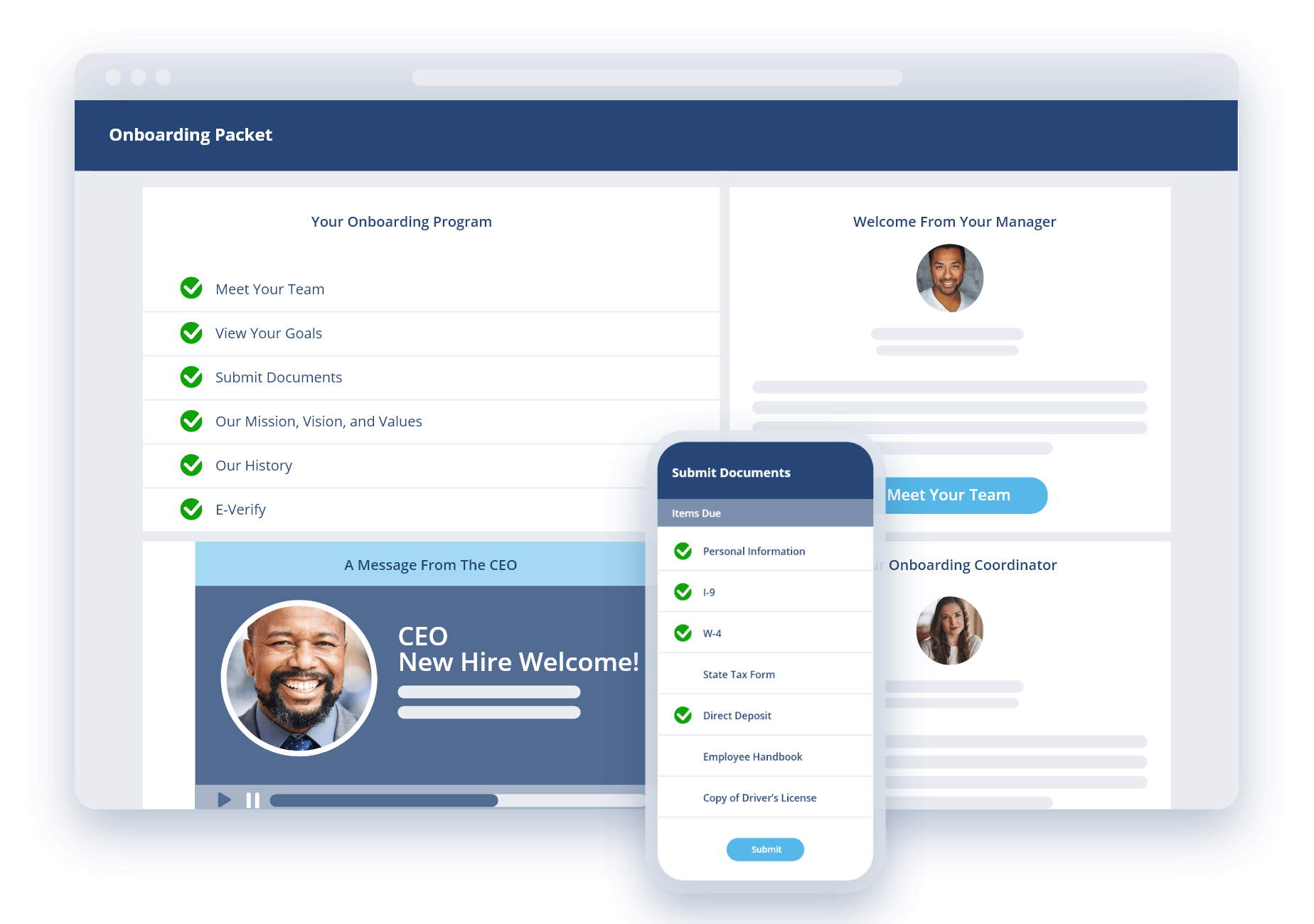This employee onboarding guide was first published in January 2018 and updated in February 2025 with new information.
Is your company starting off on the right foot with new employees? Onboarding is a significant part of the employee experience — a different kind of first impression that can leave new hires excited for the future or running for the door.
However, only 12% of employees think their company does onboarding well, and retaining new hires is a challenge. Up to 20% of costly employee turnover happens within the first 45 days in their role.
Though it may take a little more time in the first few months, an employee onboarding process is worth it. Research shows that organizations with a standard onboarding process can increase retention by 50% and even experience 62% greater new hire productivity. An excellent onboarding plan also increases employee engagement long-term.
Keep reading to learn more about onboarding new employees and why it’s important. Then, download our complete employee onboarding guide and checklist to help revamp or kick off your own process.
What Is Employee Onboarding?
Employee onboarding is the process of transitioning from candidate to employee, settling into a new role, and taking on the role's responsibilities. It begins as soon as a candidate accepts an employer’s offer and continues as they become “onboarded” into the company as employees. Onboarding tasks range from completing new hire paperwork to learning the company software and systems, meeting the team, setting new hire performance goals, and getting familiar with company culture.
Onboarding software helps facilitate the process by streamlining tasks and simplifying communication. It typically features a digital dashboard, giving talent acquisition teams a single source of truth. The dashboard allows them to track each hire's progress as they move through the onboarding stage of employment.
The best onboarding software acts as a connection between the organization’s applicant tracking, performance management, and employee engagement systems. When these systems are connected, it’s easier to maintain accuracy, eliminate redundancies, and effortlessly create detailed records of employee journeys. You can also gain more insight into:
- Employee performance and engagement over time
- The most effective way to onboard employees
- The time it takes for employees to become fully ramped (or productive)
Why Is Onboarding Important?
Your onboarding plan helps new hires feel welcome, gives them a blueprint for how to succeed, and sparks the connections that help them thrive.
- Better New Hire and Employee Retention
It’s not uncommon to lose new hires during their first few weeks or months at a job. Increase the chances that they’ll stay with a formal onboarding process: some companies have seen retention increase by as much as 50% when they started their own.
An excellent onboarding experience has a ripple effect — 69% of employees will still be at your company three years later if they say their onboarding experience was a good one.
- Reduced Time to Productivity
Time-to-productivity refers to the length of time it takes employees to reach their full performance potential in a new role. According to Gallup research, that’s usually around 12 months — one full year. While it doesn’t need to last 12 months, the average length of a good onboarding program is 90 days.
Unfortunately, lots of employees complete onboarding on their start date, with 43% saying their “onboarding program” was comprised of just one day of orientation (which isn’t the same thing) and a welcome packet. That’s no doubt why many say they feel unprepared after onboarding.
Onboarding vs. Orientation
Employee orientation is just one part of the larger employee onboarding process. Orientation programs typically take place on employees’ first day or over their first few days. They are a series of events and tasks that focus on getting employees the equipment and access they need — whether that’s a laptop, logins for software programs, personal protective equipment (PPE), or a PIN number to use when clocking in and out.
Onboarding, on the other hand, is the period when new hires become involved in company culture, grow their relationships with their coworkers, learn policies and procedures, and start taking on the responsibilities of their role.
You can help employees reach full productivity faster when you set performance goals in the onboarding process. That helps managers quickly see if employees are on track to be ready to take on their roles or if they need to adapt onboarding plans to address any challenges. Either way, you can get employees fully ramped far more quickly when you’re following a plan. You’re also likely to see increased productivity, with companies reporting up to 62% higher productivity with an onboarding plan.
- Increased Engagement
Onboarding is your chance to capture new employees’ enthusiasm by setting expectations and establishing strong connections that keep them interested in their work and loyal to your company. Great onboarding can lead to a 54% increase in engagement.
- Improved Company Culture
How you manage the employee lifecycle impacts your culture, and onboarding is a foundational part of that lifecycle. As such, it’s not too bold to claim that onboarding is part of the very foundation of company culture. Culture is often a factor in why employees accept job offers, and onboarding is when you can reinforce what they already know and love about it.
- ROI That Grows
Investing in an onboarding system isn’t an insignificant business cost, but that’s because it generates ROI indefinitely. An onboarding system won’t have high returns the first year that then start to drop off. If you’re using it wisely, you can expect to see ROI climb year after year due to many factors:
- Better employee retention over a sustained period leads to lower hiring costs and an invaluable depth of knowledge among your workforce.
- Engaging employees from their first day helps maintain motivation, leading to increased innovation.
- Employees who have excellent onboarding experiences talk about them, becoming brand ambassadors whose endorsements attract more top talent to your organization.
Employee Onboarding Best Practices
What does it take to create a successful onboarding process? Understand the strategies that are proven to be effective in preparing, engaging, and retaining new employees. We’ll share a few best practices and methods for ensuring your onboarding plan is as effective as possible.
1. Don’t Stop — Or Start — At Day One
A great new hire onboarding plan consists of more than just one day of doing paperwork and meeting the team. It takes more than a few days for new hires to acclimate to their workload, company culture, and team processes. Extending the onboarding process to months instead of weeks helps increase the likelihood that your new employees will be more successful in their roles in the long term.
When new hires start onboarding prior to day one, they’re free to focus on meeting their coworkers, learning about company values, and preparing for their roles. Before their first day, send new hires their paperwork to complete and have managers reach out with a welcome message. Their equipment, company swag, and onboarding plan should also be prepared before their first day arrives.
2. Set Onboarding Objectives
To effectively onboard new hires, give them goals to work toward right off the bat. Providing direction right away can help calm nerves and give employees a clear picture of what they’re expected to accomplish during onboarding. Set short-term goals like scheduling a week-one chat with someone from a different department. Long-term goals might include understanding the company’s mission, vision, and values.
Achieving goals during the onboarding process helps new hires jump right into their role and gives them a sense of accomplishment. It also helps them become more familiar with the company.
3. Incorporate a Mentorship Program
Bringing a mentorship component to your onboarding plan for new hires is beneficial in several ways:
- Gives employees a headstart on building relationships with coworkers
- Provides opportunities for professional development
- Facilitates trust between employees
Pairing new hires with a mentor shows that you care about their growth and success, which is exactly what job seekers today are looking for. Mentors are a great resource for new hires. Beyond answering questions and being a friendly face, mentors help new employees develop a connection to their colleagues, goals, and work environment.
A mentorship program is beneficial for employees in remote positions whose hiring and onboarding take place virtually and who may never step foot in an office. It’s also another impactful retention tool, with mentors and mentees showing far higher retention rates (69% and 72%, respectively) than employees without mentors (49%).
4. Give Feedback and Recognition
Offering feedback and recognizing accomplishments have a positive impact on new hire onboarding. Meet with new employees often during their onboarding to answer questions and offer guidance. When they complete training or their first project, recognizing their achievements helps them feel more connected to their work from the start.
Incorporating feedback and recognition in your onboarding plan for new hires makes it clear that those are important components of company culture. That matters to your new employees: companies with recognition programs see 31% lower voluntary turnover compared to those that don’t.
The 4 Cs of Employee Onboarding
The 4 Cs are the building blocks of a successful onboarding program. The 4 Cs can help your hiring team set goals for new hires to motivate them and ensure the onboarding process stays on track.
- Level 1: Compliance
- Level 2: Clarification
- Level 3: Culture
- Level 4: Connection
5. Use Software for New Hire Onboarding
Utilizing technology in the employee onboarding process can make a huge difference in completing the required documentation quickly. With onboarding software, new employees use an employee portal to complete the required paperwork before their first day of work — no paper required. HR teams can easily access digital files and spend less time tracking down documents and entering new hires’ personal information manually.
HR can use an onboarding system to set up team member introductions to help new employees get to know their coworkers before their first day. Hiring managers can set goals for new hires to meet during onboarding. Schedule check-ins at 30, 60, and 90 days to ensure new employees are on track for a successful onboarding process.
Digital onboarding software also gives you access to reporting and analytics that enable better processes. You can see the relationships between onboarding and employee satisfaction trends, performance, and more. You’ll have the information your team needs to continually refine your process and empower every new hire.
Find the Best Onboarding Software for Your Company
Now that you know how to design an excellent onboarding experience, you need the right software solution to execute your plan. Try a single, unified talent management system like ClearCompany to handle everything from hiring to people analytics.
Get our Employee Onboarding Guide and Checklist for more strategies and tools you can use to improve the new hire experience.



